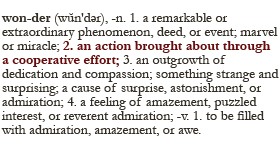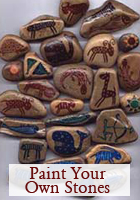Introduction
In the section entitled “Oil and Vinegar” we learned of the miracle man R. Hanina Ben Dosa. Let’s examine another miracle story connected to this intriguing individual.
In her article "Reading Midrash Today: A Study of "Rabbi Hanina ben Dosa and His Stone" in Song of Songs Rabbah 1.4" Rella Kushelevsky analyzes a miracle of R. Hanina ben Dosa found in Kohelet Rabbah 1:1:
It is related that once, seeing the men of his town taking burnt-offerings and peace-offerings up to Jerusalem, he [R. Hanina ben Dosa, renowned for his poverty] exclaimed, "All of them take peace-offerings up to Jerusalem and I have nothing to take! What am I to do?" Forthwith he went out to the desert land near his town, to the ruins of his town, and found a stone there, which he went and chiseled and polished and painted, And then he said: "I vow to take this up to Jerusalem." He wanted to engage some carriers and said to them: "Will you take this stone up to Jerusalem for me?" They said: "Pay us a hundred gold coins and we will take your stone up to Jerusalem for you." He replied: "And whence am I to get a hundred gold coins or even fifty to give you?" He could not raise the money just then and they went away. Straight-way the Holy One, blessed be He, placed in his way five angels in the form of men, They said to him: "Master, give us five sela and we will take your stone up to Jerusalem, only you must lend a hand.' He lent a hand and immediately they found themselves standing in Jerusalem, He wanted to pay them but they had disappeared. The incident was reported in the Chamber of Hewn Stone and they said to him: "It would appear, sir, that ministering angels brought your stone up to Jerusalem," Forthwith he gave the Sages the sum which he had agreed to pay the angels.
A Collective Effort
Rabbi Hanina ben Dosa lived in the lower Gallilee at the end of the second Temple period, in a city named 'Arab' not far from Zepphoris. While seeing people sending offerings to the Temple in Jerusalem, an enormous sense of despondency overcame him. R. Hanina lived in abject poverty and had nothing to offer. He decided to send a stone to the Temple. One understandably wonders the logic behind his decision. After all, stones are found in abundance in Jerusalem, the Temple was already standing. Why bring coals to Newcastle?
R. Hanina, we are told, chiseled and polished and painted his stone, thereby making it uniquely his own. His creativity transformed the stone into a personal offering worthy of making its way to the Temple in Jerusalem. Unfortunately, Hanina found himself unable to lift the stone or transport it. Again the reader questions why he made a gift that he could not deliver?
Yet perhaps this is precisely the point. R. Hanina needed help. The project had to be done collectively. The midrash describes the undertaking:
He wanted to engage some carriers and said to them: "Will you take this stone up to Jerusalem for me?" They said: "Pay us a hundred gold coins and we will take your stone up to Jerusalem for you." He replied: "And whence am I to get a hundred gold coins or even fifty to give you?" He could not raise the money just then and they went away. Straight-way the Holy One, blessed be He, placed in his way five angels in the form of men, They said to him: "Master, give us five sela and we will take your stone up to Jerusalem, only you must lend a hand.' He lent a hand and immediately they found themselves standing in Jerusalem.
R. Hanina's initial difficulty was financial, but even when he was able to come up with the money to hire porters the job was not doable without cooperation. The angels tell Hanina "only you must lend a hand." He lent a hand and immediately they found themselves standing in Jerusalem."
Rella Kushelevsky ingeniously zeroes in on this point, noting that R. Hanina lived just prior to the destruction of the Temple. He finds himself embroiled in 'the dialectical tension between destruction and construction'. His initiative seems futile in light of the winds of war and destruction, however, it is precisely at the lowest ebbs that tides can turn. His situation reflects the larger reality. Perhaps R. Hanina hopes against hope that he can prevent the destruction through restoring unity. Working together to get the stone to Jerusalem is symbolic of the cooperative efforts that can bring about miracles. And indeed when he lends a hand the miracle occurs, and R. Hanina and his helpers are wondrously transported to the Temple in Jerusalem.
Long-Range Vision
Another possibility as to why R. Hanina sent a stone to the Temple in Jerusalem is that he was already making plans for the third temple. In the words of the Psalms:
The stone that the builders rejected has become the chief cornerstone. This is the Lord’s doing; it is marvelous in our sight. This is the day that the Lord has made – let us exult and rejoice on it.
(Ps. 118:22-24)
In the face of adversity R. Hanina ben Dosa looked beyond to the next chapter of Jewish history, to a new beginning.
R. Hanina was a student of Rabban Yohanan ben Zakkai. He too faced the hurban with far range vision. Knowing that the destruction was inevitable, he asked the Roman emperor for the city of Yavneh and its wise men. Setting up a yeshiva-centered reality to replace the Temple-centered world which had been shattered. Even such tenacity and resilience in times of despair could be seen as miraculous.
What was it that enabled R. Hanina's miracle to come about? How was he suddenly airlifted along with five angels and an unliftable stone to the Temple? Rella Kushelevsky makes the following observation about our miracle:
Surprisingly, the massive stone flies through space, denying the natural consequences of its dimensions. Its paradoxical nature in the story is expressed in its ability to defy the factors of weight and size, to dislodge itself from its place and transport itself to some other location. This alteration of the laws of nature is made possible by the touch of a hand, expressing the intention that the stone in essence be part of the foundation of the Temple. This resolve is also reflected in the description of R. Hanina ben Dosa's actions in the beginning of the story. By chiseling and painting the stone and by vowing to bring it to Jerusalem, an insignificant stone (simply "a stone") becomes unique. According to R. Hanina ben Dosa's perception of reality as revealed in the story, the laws of nature are determined by a sense of resolve that is attuned to God's will. Reality is open to varying definitions, depending on inner criteria. This is a dynamic view of reality, one that does not distinguish between nature and miracle, but defines them in dialectical relationship to one other. Miracles are natural phenomena, just as nature is miraculous. Thus reality may be more a function of one's way of contemplating things than an expression of an objective situation." [1]Rella Kushelevsky, "Reading Midrash Today: A Study of "Rabbi Hanina ben Dosa and His Stone" in Song of Songs Rabbah 1.4" in Torah of the Mothers (Jerusalem, 2000) p. 331
The operative conclusion of the story of R. Hanina ben Dosa and the flying stone may be more than the contemplation of reality in miraculous terms. It would seem that God's intervention through His manifestations and emissaries are in direct response to our actions. R. Hanina's belief, in the face of the hurban, in light of his poverty and inadequacy, plus his faith in others and in a brighter future, all may have contributed to his merit and inspired the Master of the Universe to come to his aid and perform a miracle.











